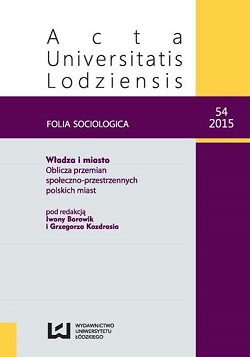The Basque approach to urban regeneration. The cultural code of “the Guggenheim Effect”
DOI:
https://doi.org/10.18778/0208-600X.54.08Keywords:
Guggenheim Museum, revitalization, urban regeneration, Basque CountryAbstract
In this article I analyze the so-called: “Bilbao effect”. I am interested primarily in the relationship between the revitalization of Bilbao with its iconic building – the Guggenheim Museum and the Basque culture, i.e. the Basque way of life and the Basque values. The starting point of this analysis is the concept of “urban regeneration through culture”, which is usually understood in one of two ways. The first meaning refers to such activities that rely on the use of cultural institutions in the urban regeneration projects, whereas the second refers to the activities that engage and activate (local) artists. Both interpretations tend, however, to distort the meaning of culture. In both cases it is understood very narrowly and operates merely as the synonym of “the arts”. Basing on Znaniecki’s definition, who understood culture, not only in material terms but also as everything that falls within the category of so-called “intangible creations of human activity”, I analyze the “cultural dimension” of urban regeneration of Bilbao not through the typical presentation of Guggenheim Museum as a cultural institution, but rather through the choice of revitalization strategies and its socio-cultural basis. In doing so, I explore the connections between the Guggenheim Museum in Bilbao and the Basque political philosophy, Basque economic values, and the Basques image of themselves.
References
Ashworth G., Kavaratzis M. (2014), Cities of Culture and Culture in Cities: The Emergent Uses of Culture in City Branding, [w:] Haas T., Olsson K. (eds.), Emergent Urbanism: Urban Planning & Design in Times of Systemic and Structural Change, Ashgate, Aldershot.
Google Scholar
Clark G., Huxley J., Mountford D. (2010), Organising Local Economic Development. The Role of Development Agencies and Companies, OECD.
Google Scholar
DOI: https://doi.org/10.1787/9789264083530-en
Dymnicka M. (2013), Przestrzeń publiczna a przemiany miasta, Scholar, Warszawa.
Google Scholar
Gibson L., Stevenson D. (2004), Urban Space and the Uses of Culture, „International Journal of Cultural Policy”, no. 10, s. 1–4.
Google Scholar
DOI: https://doi.org/10.1080/1028663042000212292
Gómez M., González S. (2001), A Reply to Beatriz Plaza’s ‘The Guggenheim-Bilbao Museum Effect’, “International Journal of Urban and Regional Research”, vol. 25, no. 4, s. 898−900.
Google Scholar
DOI: https://doi.org/10.1111/1468-2427.00351
Gray C. (2015), A Fiscal Path to Sovereignty? The Basque Economic Agreement and Nationalist Politics, “Nationalism and Ethnic Politics”, vol. 21, no. 1, s. 63−82.
Google Scholar
DOI: https://doi.org/10.1080/13537113.2015.1003489
Hughes R. (1997), Bravo! Bravo! R. Meier’s Getty Center and F. Gehry’s Guggenheim Museum, “Time”, no. 150.
Google Scholar
Kavaratzis M., Ashworth G. (2015), Hijacking Culture: The Disconnection Between Place Culture and Place Brands, “The Town Planning Review”, vol. 86, no. 2, s. 155−176.
Google Scholar
DOI: https://doi.org/10.3828/tpr.2015.10
Johnson L. (2009), Cultural Capitals. Revaluing the Arts, Remaking Urban Spaces, Ashgate Publishing Co., Farnham.
Google Scholar
MacClancy J. (2007), Expressing Identities in the Basque Arena, Long House Publishing Services, Oxford–Santa Fe.
Google Scholar
McEwan C. (2005), Geography, Culture and Global Change, [w:] Daniels P. et al. (eds.), An Introduction to Human Geography: Issues for the 21st Century, Pearson, Harlow.
Google Scholar
Michael Ch. (2015), The Bilbao Effect: Is ‘starchitecture’ all it’s cracked up to be? A history of cities in 50 buildings, day 27, “The Guardian”, 30.04. [online].
Google Scholar
Muschamp H. (1997), The Miracle in Bilbao, “New York Times Magazine”, no. 146.
Google Scholar
Orzechowska-Wacławska J. (2014a), Baskijskie polityki miejskie. Konstruowanie nowej symboliki i nowego oblicza Bilbao, „Politeja”, nr 27, s. 209−227.
Google Scholar
DOI: https://doi.org/10.12797/Politeja.11.2014.27.10
Orzechowska-Wacławska J. (2014b), Baskowie. Powstawanie współczesnego narodu, Wydawnictwo Uniwersytetu Jagiellońskiego, Kraków.
Google Scholar
Plaza B. (2008), On Some Challenges and Conditions for the Guggenheim Museum Bilbao to be an Effective Economic Re-activator, “International Journal of Urban and Regional Research”, vol. 32, no. 2, s. 506−517.
Google Scholar
DOI: https://doi.org/10.1111/j.1468-2427.2008.00796.x
Plaza B. (2006), The Return on Investment of the Guggenheim Museum Bilbao, “International Journal of Urban and Regional Research”, vol. 20, no. 2, s. 452−467.
Google Scholar
DOI: https://doi.org/10.1111/j.1468-2427.2006.00672.x
Plaza B., Haaruch S. N. (2015), The Guggenheim Museum Bilbao: Between Regional Embeddedness and Global Networking, “European Planning Studies”, vol. 23, no. 8, s. 1−20.
Google Scholar
DOI: https://doi.org/10.1080/09654313.2013.817543
Santamaría G. del Cerro (2007), Bilbao. Basque Pathways to Globalization, Elsevier, Amsterdam.
Google Scholar
Scott A. J. (2014), Beyond the Creative City: Cognitive – Cultural Capitalism and the New Urbanism, “Regional Studies”, vol. 48, no. 4, s. 565−578.
Google Scholar
DOI: https://doi.org/10.1080/00343404.2014.891010
Seligmann A. D. (2008), Architectural Publicity in the Age of Globalization, PhD Dissertation, University of California, Los Angeles.
Google Scholar
Serra E. M. (2011), La revitalización del área metropolitana de Bilbao: La gestión del Bilbao Ría 2000, aspectos territoriales, “Boletín de la Asociación de Geógrafos Españoles”, no. 55, s. 35–57.
Google Scholar
Swidler A. (1986), Culture in Action: Symbols and Strategies, “American Sociological Review”, no. 51, s. 273−286.
Google Scholar
DOI: https://doi.org/10.2307/2095521
Urban Redevelopment Authority (2012), Cities in Transformation: Lee Kuan Yew World City Prize, Tien Wah Press, Singapore.
Google Scholar
Vicario L., Martínez Monje P. M. (2003), Another ‘Guggenheim Effect’? The Generation of a Potentially Gentrifiable Neighbourhood in Bilbao, “Urban Studies”, vol. 40, no. 12, s. 2383–2400.
Google Scholar
DOI: https://doi.org/10.1080/0042098032000136129
Zabaleta I. (1999), The Basques in the International Press: Coverage by the New York Times (1950−1996), [w:] Douglass W. A. et al. (eds.), Basque Politics and Nationalism on the Eve of the Millennium, University Nevada Press, Reno.
Google Scholar
Zulaika J. (2001), Krens’s Taj Mahal: The Guggenheim’s Global Love Museum, “Discourse”, vol. 23, no. 1, s. 100−118.
Google Scholar
DOI: https://doi.org/10.1353/dis.2001.0009
Downloads
Published
How to Cite
Issue
Section
License
Copyright (c) 2015 © Copyright by Joanna Orzechowska-Wacławska, Łódź 2015; © Copyright for this edition by Uniwersytet Łódzki, Łódź 2015

This work is licensed under a Creative Commons Attribution-NonCommercial-NoDerivatives 4.0 International License.










